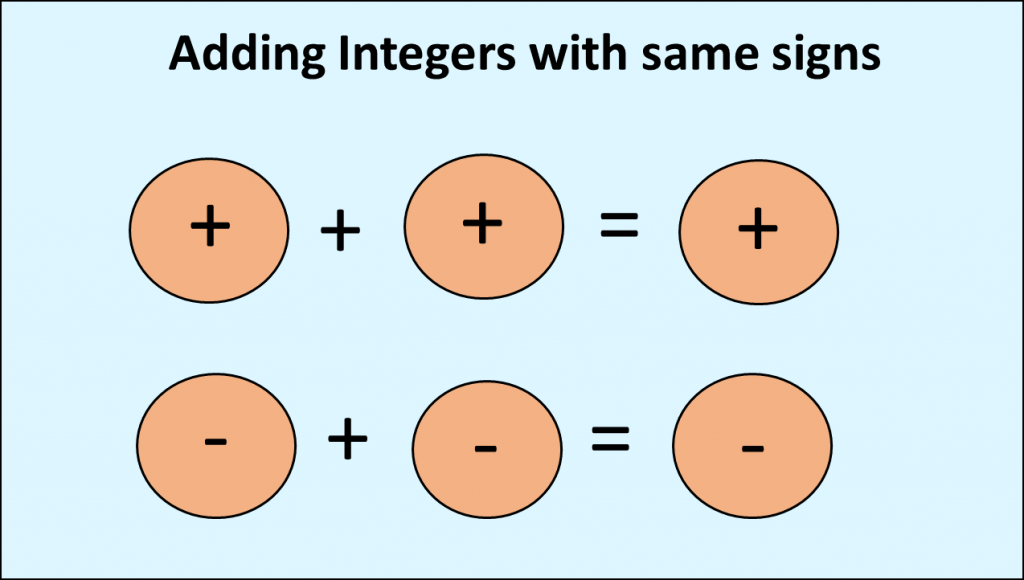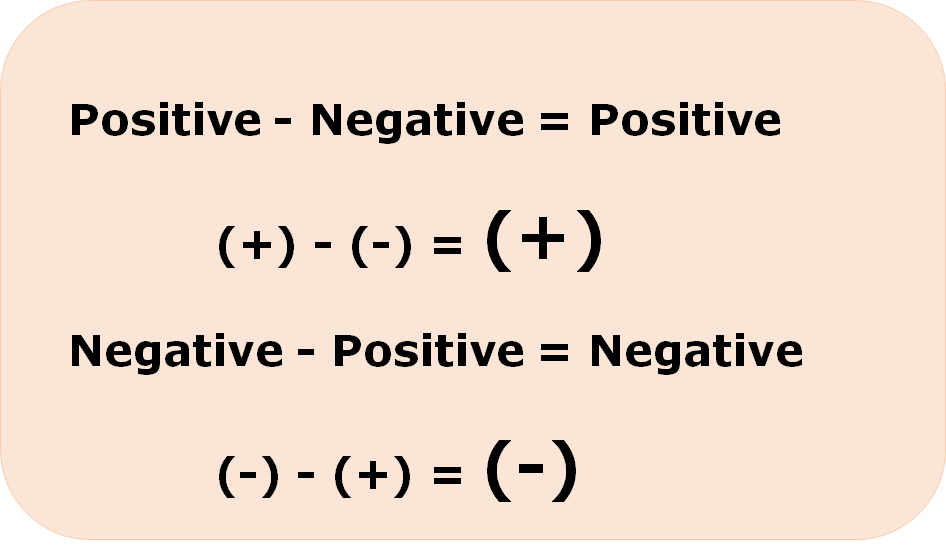Addition of Integers – Rules
Rules – Addition of Integers
There are two conditions when adding integers.

Rule 1: When integers have same sign.

Rule 2: When integers have opposite sign.
(a) When integers have same sign.
(b) When integers have opposite sign.
a. Integers having (same)positive sign.
When we add two positive integers means both integers have positive sign, then add the integers and assign the positive sign to the sum.
Example: 2 + 5 = +7
4 + 6 = 10
23 + 14 = +37
90 + 45 = +135
(Plus) + (Plus) = (Plus) or
(+) + (+) = +
Note: Here we have two positive integers, so we add them and attach the positive sign to the sum.
Remember: If any integer has no sign means it means positive(+).
b. Integers having (same)negative sign.
When we add two negative integers means both integers have negative sign, then add the integers and assign the negative sign to the sum.
Example: (-3) + (-9) = – 12
(-4) + (-7) = – 11
(-34) + (-6) = – 40
(-25) + (-56) = – 81
(Minus) + (Minus) = (Minus) or
(-) + (-) = –
Note: Here we have two negative integers, so we add them and attach the negative sign to the sum.
Rule 2: When integers have opposite sign.
Find the difference of positive and negative integers and keep the sign of the integer having greater value.
There are two cases.
1. When positive integer is greater than negative integer.
2. When negative integer is greater than positive integer.
Example: (+36) + (-5) = ?
In this example there are two integers +36 and -5, both have opposite signs, 36 has positive sign and 5 has negative sign. So, first we find the difference of the integers. The difference of integers is 31, now attach the sign of the integer having greater value.
Here, integer +36 is greater and positive sign, so we attach plus sign before the difference that is 31 so answer is (+31).
Therefore, (+36) + (-5) = +31
(+60) + (-15) = +45
(-74) + (+32) = – 42
Example: (-23) + (+6) = ?
In this example there are two integers -23 and +6, both have opposite signs, 23 has negative sign and 6 has positive sign. So, first we find the difference of the integers. The difference of integers is 17, now attach the sign of the integer having greater value.
Here, integer 23 has greater and negative sign, so we attach minus sign before the difference, that is 17 so answer is (-17).
Therefore, (-23) + (+6) = – 17
Note: Adding a negative number is same as subtracting a positive number.
Example: 8 – 3 = 5
(- 8) + (-3) = – 11
(- 8) + (-3) = – 8 – 3 = – 11
Subtracting a negative integer from another negative integer, subtract and keep the sign of greater integer.
Example: (- 6) – (- 2) = – 6 + 2 = – 4
Rule 3: The sum of an integer and its opposite is equal to zero.
Example: (-42) + (+42) = 0
(-25) + (+25) = 0
(+67) + (-67) = 0
Conclusion:


(Positive + Positive) = Positive
(+) + (+) = +
(Negative + negative) = Negative
(-) + (-) = –
(Positive – negative) = Positive
(+) – (-) = +
(negative + Positive) = negative
(-) + (+) = –